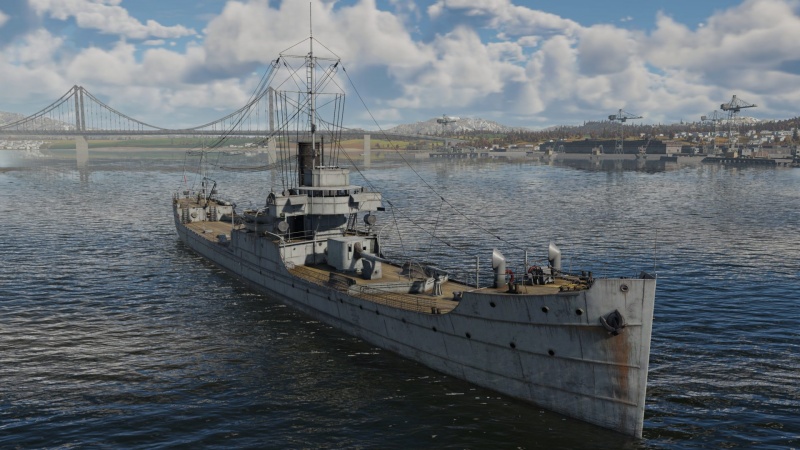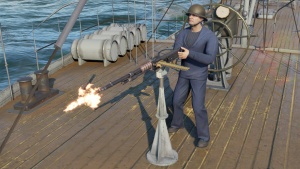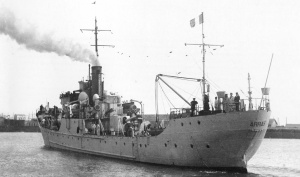Arras
Contents
Description
Arras was a French sloop of the Arras-class, built in 1917 and launched in July 1918, but did not see any combat before the end of the First World War just 4 months later. After the war, she served with the French Navy, spending time in reserve during the interwar period. Recommissioned for the Second World War, Arras took part in the defence of Dunkirk in 1940. Following the fall of France, she was captured by the British at Portsmouth on 3 July 1940 as part of Operation Catapult and transferred to the Free French Naval Forces, where she served as a barrack ship and a source of spare parts for her sister ship Amiens. After the war, Arras was decommissioned and scrapped in 1946.
Introduced in Update "Dance of Dragons" along with the official release of the French coastal tree, Arras-class, Arras is a French sub-chaser capable of sinking most small coastal vessels with a single round, giving it unique gameplay. Other than her signature armament, she features excellent survivability and surprisingly good mobility for a ship made to look like a merchant vessel. Her biggest downside is the secondary and anti-air guns, both of which struggle to deal with either surface or aerial targets, making positioning and bringing the main guns to bear on surface targets an absolute necessity.
General info
Survivability and armour
Despite lacking any hull armour and having a 16 mm steel hull, which is thinner than that of the L9059, Arras has significantly better survivability. There are a few contributing factors to this: its much larger crew complement and a better distribution of said crew, fuel tanks protecting the boiler rooms, and multiple internal compartments, which together provide much better protection than would otherwise be expected.
Mobility
Despite having the appearance of a slow cargo ship, this sloop is faster than many motor gun boats or even sub-chasers. This, combined with excellent manoeuvrability, makes Arras a surprisingly difficult target, being able to dodge torpedoes or bring its guns to bear on target much more quickly than would otherwise be expected.
| Mobility Characteristics | |||
|---|---|---|---|
| Game Mode | Upgrade Status | Maximum Speed (km/h) | |
| Forward | Reverse | ||
| AB | |||
| Upgraded | |||
| RB/SB | |||
| Upgraded | |||
Modifications and economy
From Rank I, the 138.6 mm SAP shell is a very tempting choice, but in most encounters, regular HE does the job reasonably well, so a Damage Control Division might be a good first choice. In Rank II, the Rudder Replacement is the best first choice, with the Fire Division a close second, as you are likely to be set alight many times over the matches, either by cannons or near misses from bombs. Primary Armament Targeting is the best first choice for Rank III, with Shrapnel Protection being a second choice. Finally, Engine Maintenance should be your go-to in Rank IV. The least important modification is arguably the Improved Rangefinder, as you are unlikely ever to engage targets at such a long range that the +14% accuracy would make a perceivable difference.
Armament
Primary armament
The main armament of the vessel consists of two 138.6 mm guns, a calibre shared with the battleship secondaries and destroyer primaries.
HE shells will overpressure any wooden boat and will do significant damage to sub-chasers or large motor gun boats. The larger the vessel, the more hits along the length it may need to be destroyed. When possible, avoid hitting the same spot multiple times.
SAP shells are best used against destroyers or heavily angled frigates. Against motor gunboats or submarine chasers in parallel, they are very likely to overpenetrate. They need at least 6 mm of steel to fuse, and unless a component is in the path of the projectile, it will travel nearly 42 metres before exploding. On the other hand, SAP shells can detonate magazines on enemy vessels, making them capable of one-shotting even much larger vessels, as long as they are protected by sufficiently thin armour.
| Penetration statistics | |||||||
|---|---|---|---|---|---|---|---|
| Ammunition | Type of warhead |
Penetration @ 0° Angle of Attack (mm) | |||||
| 1,000 m | 2,500 m | 5,000 m | 7,500 m | 10,000 m | 15,000 m | ||
| OEA Mle 1919 HE | HE | 36 | 36 | 36 | 36 | 36 | 36 |
| OPF Mle 1910 SAP | Common | 67 | 49 | 34 | 34 | 34 | 34 |
| Shell details | ||||||||||||
|---|---|---|---|---|---|---|---|---|---|---|---|---|
| Ammunition | Type of warhead |
Velocity (m/s) |
Projectile mass (kg) |
Fuse delay (s) |
Fuse sensitivity (mm) |
Explosive mass (TNT equivalent) (kg) |
Ricochet | |||||
| 0% | 50% | 100% | ||||||||||
| OEA Mle 1919 HE | HE | 840 | 31.5 | 0 | 0.1 | 3.41 | 79° | 80° | 81° | |||
| OPF Mle 1910 SAP | Common | 830 | 36.5 | 0.05 | 6 | 2.93 | 47° | 60° | 65° | |||
Secondary armament
A single 75 mm gun on the bow of the vessel has a very limited arc of fire, both horizontally and vertically, making it useful only in the most desperate circumstances, when the main guns are disabled or otherwise incapable of reaching targets that the 75 mm can still aim at.
The HE-TF shells, while an interesting option, are very unlikely to hit an aeroplane, given that the vertical guidance of the gun is limited to +30° and it fires just one round every 4 to 5 seconds.
| Penetration statistics | |||||||
|---|---|---|---|---|---|---|---|
| Ammunition | Type of warhead |
Penetration @ 0° Angle of Attack (mm) | |||||
| 100 m | 1,000 m | 2,000 m | 3,000 m | 4,000 m | 5,000 m | ||
| OEA Mle 1917 HE | HE | 8 | 8 | 8 | 8 | 8 | 8 |
| OPF Mle 1917 SAP | SAP | 30 | 27 | 23 | 20 | 18 | 16 |
| OEA Mle 1917 HE-TF | HE-TF | 8 | 8 | 8 | 8 | 8 | 8 |
| Shell details | ||||||||||||
|---|---|---|---|---|---|---|---|---|---|---|---|---|
| Ammunition | Type of warhead |
Velocity (m/s) |
Projectile mass (kg) |
Fuse delay (s) |
Fuse sensitivity (mm) |
Explosive mass (TNT equivalent) (g) |
Ricochet | |||||
| 0% | 50% | 100% | ||||||||||
| OEA Mle 1917 HE | HE | 570 | 6.18 | 0 | 0.1 | 450 | 79° | 80° | 81° | |||
| OPF Mle 1917 SAP | SAP | 505 | 7.92 | 0.01 | 4 | 990 | 47° | 60° | 65° | |||
| OEA Mle 1917 HE-TF | HE-TF | 570 | 6.18 | 0 | 0.1 | 450 | 79° | 80° | 81° | |||
Anti-aircraft armament
Three single 8 mm guns are, quite unusually, firing ammunition without tracers or other visible projectiles. Given the low calibre, the gun is fundamentally unlikely to score any easy kills with the use of AI gunners. But the lack of psychological effect or visual bullet tracers to lead the rounds on target during manual operation is the biggest issue of the gun.
Neither you nor the enemies will know that the anti-air gunners are engaging a target, making you a tempting target for any enemy aeroplane in proximity, as the Arras will likely be the only large target not spraying the sky with visible anti-air gunfire.
Usage in battles
Owing to being one of the largest vessels in the boat spawn, Arras can bully most of the boats competing for the capture points. While the limited firing arcs and slow rotation speed of the main guns, along with significant heeling of the vessel when making tight turns, make it non-trivial to get shots on target, the good muzzle velocity and sheer explosive power of the rounds are likely to score a number of kills under the right circumstances.
- Specific enemies worth noting
Aeroplanes are the biggest threat to the Arras, as there is no reliable way to counter them with your own armament.
Destroyers are best dealt with using SAP rounds, but generally should be avoided, as unless they are already damaged or struggle with accuracy, they can kill you much quicker than you can kill them.
Motor Torpedo Boats are mostly dangerous before the Rudder Replacement modification is installed, or if the bridge/steering gear is damaged, as torpedoes are extremely dangerous for a less manoeuvrable Arras. While those with a smaller explosive filler can be tanked directly into the bow or aft, any mistake that allows them to hit closer to the midsection is likely to end in instant death.
Pros and cons
Pros:
- Equipped with potent 138.6 mm primary guns able to one-shot most vessels in this BR
- Spawns next to other patrol boats rather than destroyers and frigates
- Excellent survivability
Cons:
- Lacks capable anti-air defence, and its large size makes it an attractive target for enemy aeroplanes
- Before unlocking mobility modifications or after having the bridge destroyed, she suffers from poor mobility, making her an attractive target for enemy torpedoes
- Gun placement and slow horizontal targeting speed make it difficult to switch between targets from multiple directions
History
Arras was the lead ship of the French Arras-class sloops (also known as the Amiens class), which were designed during the First World War following the success of the British Q-ships, which were disguised as merchant vessels to deceive enemy submarines. She was intended to escort French convoys during the war, as they were harassed by submarines of the Imperial German Navy. Built at the Arsenal de Brest, laid down in 1917 and launched in July 1918, Arras was commissioned just 4 months before the signing of the Armistice on 11 November 1918, marking the end of her wartime career without any events of note.
Following the end of the war, 13 vessels of her class were cancelled, while 29 others entered service between 1919 and 1924. During the interwar years, Arras was based in Toulon, along with other ships in her class. With the outbreak of World War Two, 19 vessels of her class were retired, and 11 were recommissioned, including Arras herself. In May 1940, she was stationed at Dunkirk, contributing to the port's anti-air defences during the German invasion, claiming to have damaged two enemy aircraft. As the city became surrounded by Germans, she evacuated British troops to Portsmouth.
After the fall of France in June 1940, Arras was among several French ships captured by British forces on 3 July 1940 as part of the larger Operation Catapult. She was subsequently transferred to the Free French Naval Forces, where she served in a more stationary role as a barrack ship. Disarmed and largely used for spare parts for her sister ship Amiens, her active service days were effectively over. After the war, Arras was returned to France but was not restored to active service. She was officially decommissioned and broken up for scrap on 25 February 1946.
Media
Excellent additions to the article would be video guides, screenshots from the game, and photos.
See also
Links to articles on the War Thunder Wiki that you think will be useful for the reader, for example:
- reference to the series of the ship;
- links to approximate analogues of other nations and research trees.
External links
| Arsenal de Brest | |
|---|---|
| Avisos | |
| Arras-class | Arras |
| Light Cruisers | |
| Duguay-Trouin-class | Duguay-Trouin · Primauguet |
| Heavy Cruisers | |
| Suffren-class | Colbert · Dupleix |
| Battleships | |
| Bretagne-class | Bretagne |
| Dunkerque-class | Dunkerque |
| France sub-chasers | |
|---|---|








